Heim >Backend-Entwicklung >C#.Net-Tutorial >Verwendung von Asp.net zur Implementierung der Datenstatistikfunktion des Informationsverwaltungssystems
Verwendung von Asp.net zur Implementierung der Datenstatistikfunktion des Informationsverwaltungssystems
- 巴扎黑Original
- 2017-08-15 13:48:582595Durchsuche
Dieser Artikel stellt hauptsächlich die Implementierungsmethode der Datenstatistikfunktion im Asp.net-Managementinformationssystem vor. Freunde, die sie benötigen, können darauf zurückgreifen.
Datenstatistik ist eine wesentliche Funktion in jedem System. Sie wird empfohlen Führungskräfte Sehr nützlich beim Melden von Statistiken und Fortschrittsdaten, die für die Arbeit benötigt werden.
Meiner Meinung nach sollte ein Statistikmodul die folgenden Funktionen implementieren:
Die statistischen Ergebnisse häufig verwendeter Abfragen anzeigen können
Die angezeigten Ergebnisse können in Tabellenform oder in grafischer Form vorliegen. Wenn es sich um eine Grafik handelt, kann sie in mehreren Formen angezeigt werden (Balkendiagramm, Liniendiagramm, Kreisdiagramm, Radardiagramm, gestapeltes Balkendiagramm usw.):
Statistische Abfrageergebnisse, klicken Sie auf Zahlen oder Prozentsätze, um detaillierte Daten anzuzeigen
Sie können Abfragebedingungen, Filterbedingungen und Gruppierungsbedingungen frei kombinieren , und Sortierung usw.;
Es ist am besten, eine Echtzeitvorschau der statistischen Ergebnisse zu haben
Abfragestatistiken können so gespeichert werden dass statistische Abfragen beim nächsten Mal direkt aufgerufen und angezeigt werden können.
Für die gespeicherten Abfragestatistiken können die Abfrageergebnisse beim nächsten Mal auch nach der flexiblen Filtermethode gefiltert werden genannt;
Die Benutzeroberfläche muss einfach und intuitiv sein, damit auch Bediener, die nicht viel über Computer wissen, sie problemlos verwenden können; 🎜>Für einige komplexe Abfragen kann SQL direkt im Hintergrund geschrieben werden oder Sp kann aufgerufen werden. Out of data
......
Okay, das Im Folgenden finden Sie die Implementierung und Anwendung in der tatsächlichen Umgebung:
Dies ist ein Student. Im Beschäftigungssystem melden Studierende ihr Abschlussziel zu unterschiedlichen Zeitpunkten an, sodass die Statistiken, die auf unterschiedlichen Zeitgrenzen basieren, unterschiedlich sind. Die Datentabelle enthält mehr als 100 Felder (nicht für alle Felder sind Statistiken erforderlich).
Zuerst erstellen wir eine Tabellenwertfunktion in der Datenbank, die Daten entsprechend verschiedenen Zeitgrenzen zurückgeben kann. Die Tabelle fungiert auch als Ansicht und bezieht den Wert der Parametertabelle direkt in das zurückgegebene Ergebnis ein.
Auf diese Weise können wir mit
die Daten für den Stichtag 25. August abfragen.
ALTER FUNCTION [dbo].[Get.............] ( @gxsj datetime ) RETURNS TABLE AS RETURN ( select t1.*, dbo.depacode.xymc, CASE t1.xldm WHEN '01' THEN '博士' WHEN '11' THEN '硕士' WHEN '25' THEN '双学位' WHEN '31' THEN '本科' WHEN '41' THEN '专科' WHEN '61' THEN '高职' ELSE '' END AS xlmc, CASE WHEN LEFT(t1.sydqdm, 2) IN ('11', '12', '13', '21', '31', '32', '33', '35', '37', '44', '46', '71', '81', '82') THEN '东部' WHEN LEFT(t1.sydqdm, 2) IN ('14', '22', '23', '34', '36', '41', '42', '43') THEN '中部' WHEN LEFT(t1.sydqdm, 2) IN ('15', '45', '51', '50', '52', '53', '54', '61', '62', '65', '63', '64') THEN '西部' ELSE '' END AS sydq, sydq.dwdqmc AS sysf, CASE WHEN LEFT(t1.dwdqdm, 2) IN ('11', '12', '13', '21', '31', '32', '33', '35', '37', '44', '46', '71', '81', '82') THEN '东部' WHEN LEFT(t1.dwdqdm, 2) IN ('14', '22', '23', '34', '36', '41', '42', '43') THEN '中部' WHEN LEFT(t1.dwdqdm, 2) IN ('15', '45', '51', '50', '52', '53', '54', '61', '62', '65', '63', '64') THEN '西部' ELSE '' END AS dwdq, dwdq.dwdqmc AS dwsf, dbo.Entcode.hyname, dbo.hydygx.hymldm, dbo.hydygx.hyml, CASE t1.xbdm WHEN 1 THEN '男' WHEN 2 THEN '女' ELSE '男' END AS xbmc, [mzdmb].[nation] AS mzmc, [EjByqxdmb].[Ejbyqxmc], dbo.byqxdygx.jybbyqx, t1.gn500 AS jybdwxzdm, CASE t1.knslbdm WHEN '7' THEN '就业困难、家庭困难和残疾' WHEN '6' THEN '家庭困难和残疾' WHEN '5' THEN '就业困难和残疾' WHEN '4' THEN '残疾' WHEN '3' THEN '就业和家庭困难' WHEN '2' THEN '家庭困难' WHEN '1' THEN '就业困难' ELSE '非困难生' END AS Knslb from [table] as t1 LEFT OUTER JOIN dbo.depacode ON t1.xydm = dbo.depacode.xydm LEFT OUTER JOIN dbo.dwdq AS sydq ON LEFT(t1.sydqdm, 2) + '0000' = sydq.dwdqdm LEFT OUTER JOIN dbo.dwdq AS dwdq ON LEFT(t1.dwdqdm, 2) + '0000' = dwdq.dwdqdm LEFT OUTER JOIN dbo.Entcode ON t1.hylb = dbo.Entcode.hycode LEFT OUTER JOIN dbo.hydygx ON t1.hylb = dbo.hydygx.hydldm LEFT OUTER JOIN [mzdmb] ON t1.mzdm = [mzdmb].[mzdm] LEFT OUTER JOIN [EjByqxdmb] ON t1.byqx2 = [EjByqxdmb].[Ejbyqxdm] LEFT OUTER JOIN dbo.byqxdygx ON t1.byqx = dbo.byqxdygx.shbyqx AND t1.dwxzdm = dbo.byqxdygx.shdwxzdm where [gxsj] <= dateadd(day,1,@gxsj) and HisId in (SELECT TOP 1 HisId FROM [table] WHERE [gxsj] <= dateadd(day,1,@gxsj) and xsxh = t1.xsxh and bynf = t1.bynf and t1.byqx not in ('08','05','11') ORDER BY [gxsj] DESC) )Der nächste Schritt ist das Interface-Design. Wir verwenden das DropableDragable-Steuerelement in jquery-ui. Die Felder werden auf der Schnittstelle angeordnet und können direkt in die entsprechenden Felder gezogen werden, um Statistiken durchzuführen.
select * from [get...]('2016-8-25')Zusätzlich zum Gruppieren von Feldern können Anzeigefelder auch eine statistische Filterung basierend auf bestimmten Werten durchführen und so die Funktion mehrerer Gruppierungsstatistiken erfüllen.
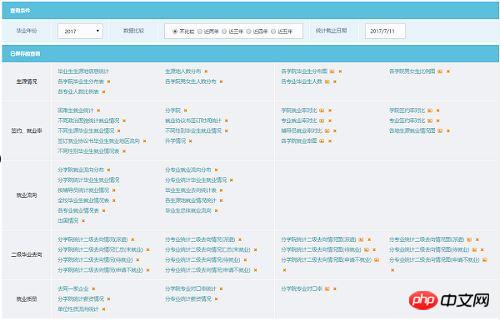
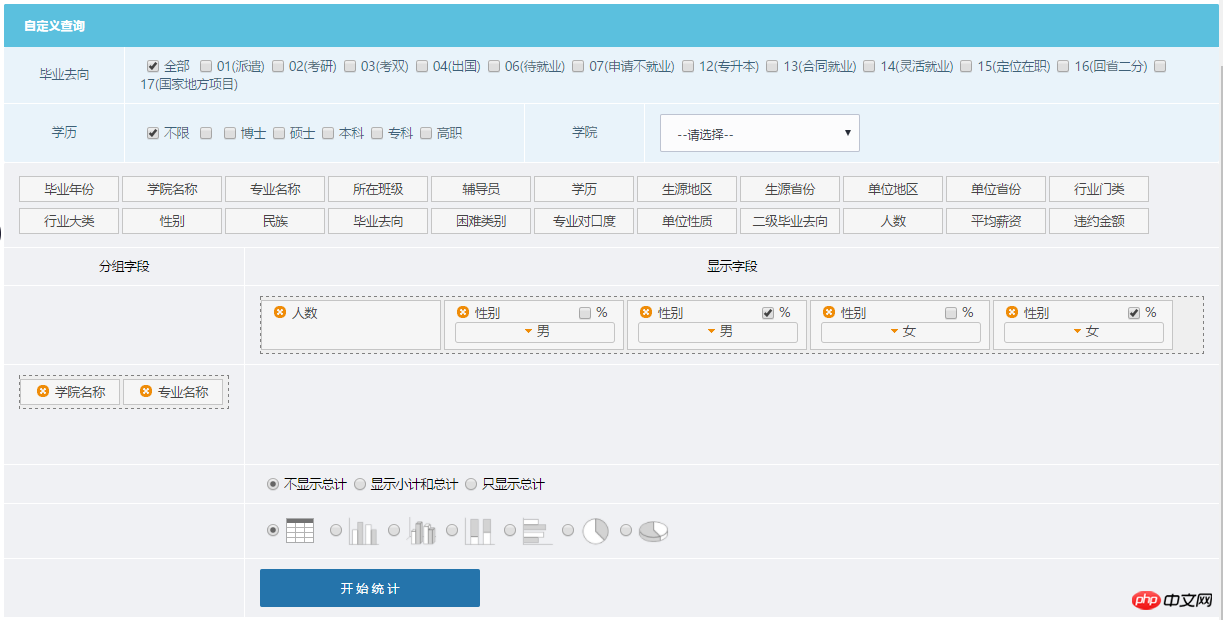 Statistik in tabellarischer Form anzeigen Sie können sehen, dass jeder Wert auf das Popup-Feld geklickt werden kann, um Details anzuzeigen. Unten können Abfragebedingungen gespeichert und grafisch angezeigt werden:
Statistik in tabellarischer Form anzeigen Sie können sehen, dass jeder Wert auf das Popup-Feld geklickt werden kann, um Details anzuzeigen. Unten können Abfragebedingungen gespeichert und grafisch angezeigt werden:
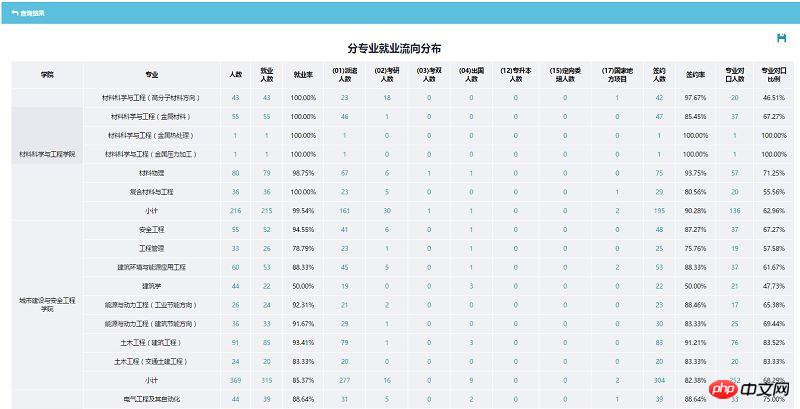


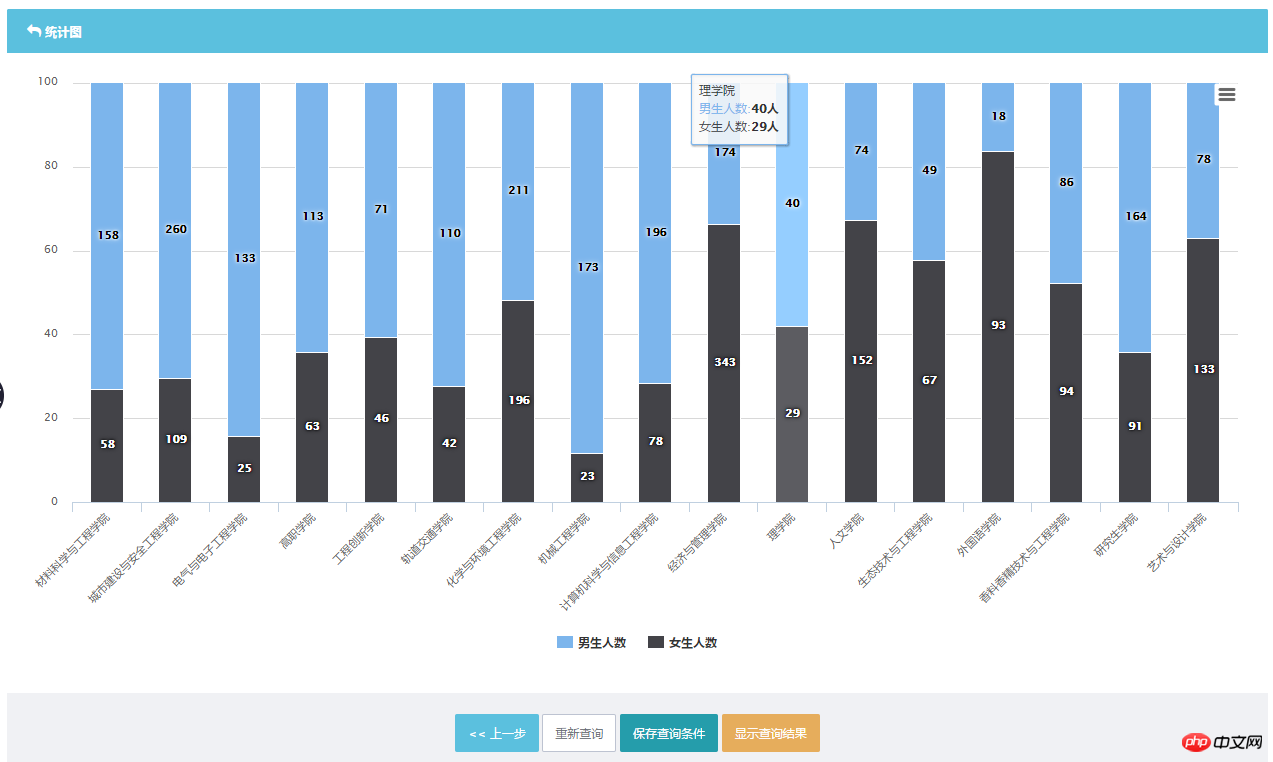
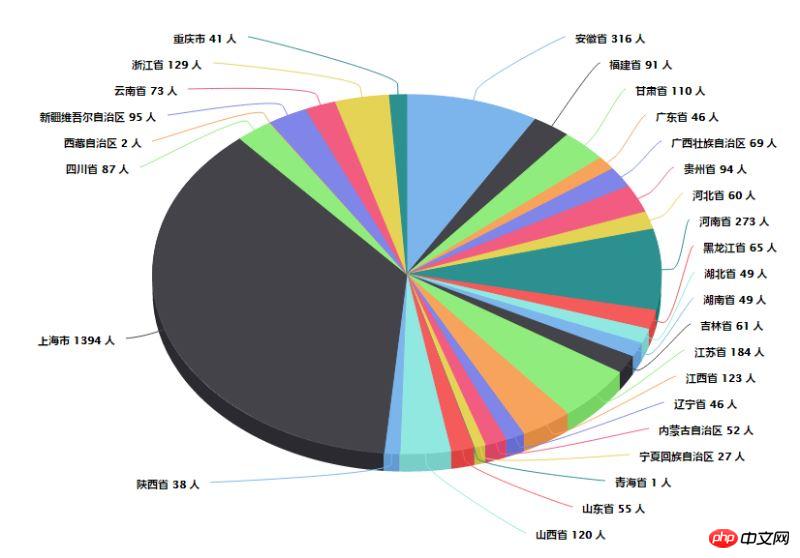 Feldentitätsklasse (Teil)
Feldentitätsklasse (Teil)
Kontrollklasse
[Serializable]
[XmlInclude(typeof(BYNF_InquireField))]
[XmlInclude(typeof(Count_InquireField))]
[XmlInclude(typeof(XYMC_InquireField))]
[XmlInclude(typeof(ZYMC_InquireField))]
[XmlInclude(typeof(SZBJ_InquireField))]
[XmlInclude(typeof(FDY_InquireField))]
[XmlInclude(typeof(XL_InquireField))]
[XmlInclude(typeof(SYDQ_InquireField))]
[XmlInclude(typeof(SYSF_InquireField))]
[XmlInclude(typeof(DWDQ_InquireField))]
[XmlInclude(typeof(DWSF_InquireField))]
[XmlInclude(typeof(HYML_InquireField))]
[XmlInclude(typeof(HYDL_InquireField))]
[XmlInclude(typeof(XBMC_InquireField))]
[XmlInclude(typeof(MZMC_InquireField))]
[XmlInclude(typeof(BYQX_InquireField))]
[XmlInclude(typeof(KNSLB_InquireField))]
[XmlInclude(typeof(ZYDKL_InquireField))]
[XmlInclude(typeof(DWXZ_InquireField))]
[XmlInclude(typeof(EJBYQXMC_InquireField))]
[XmlInclude(typeof(GZ_InquireField))]
[XmlInclude(typeof(WYJE_InquireField))]
public abstract class InquireFieldBase
{
public InquireFieldBase()
{
FieldItems = this.GetInquireItemsByInquireType();
}
[XmlAttribute]
public int FieldDisplayOrder { get; set; }
[XmlAttribute]
public string FieldName { get; set; }
[XmlAttribute]
public string DbName { get; set; }
[XmlAttribute]
public bool IsAggregate { get; set; }
[XmlAttribute]
public InquireHelper.FieldType FieldType { get; set; }
//用于highchart统计
[XmlAttribute]
public bool IsNameField { get; set; }
//用于统计输出数据
[XmlAttribute]
public bool IsPercent { get; set; }
[XmlIgnore]
public List<string> FieldItems { get; set; }
public List<string> FieldValue { get; set; }
public bool? OrderByAsc { get; set; }
}
[Serializable]
public class BYNF_InquireField : InquireFieldBase
{
public BYNF_InquireField()
{
FieldDisplayOrder = 1;
FieldName = "毕业年份";
DbName = "BYNF";
}
}
[Serializable]
public class XYMC_InquireField : InquireFieldBase
{
public XYMC_InquireField()
{
FieldDisplayOrder = 5;
FieldName = "学院名称";
DbName = "XYMC";
}
}
[Serializable]
public class ZYMC_InquireField : InquireFieldBase
{
public ZYMC_InquireField()
{
FieldDisplayOrder = 6;
FieldName = "专业名称";
DbName = "ZYMC";
}
}
[Serializable]
public class SZBJ_InquireField : InquireFieldBase
{
public SZBJ_InquireField()
{
FieldDisplayOrder = 7;
FieldName = "所在班级";
DbName = "SZBJ";
}
}
[Serializable]
public class FDY_InquireField : InquireFieldBase
{
public FDY_InquireField()
{
FieldDisplayOrder = 8;
FieldName = "辅导员";
DbName = "FDY";
}
}
[Serializable]
public class XL_InquireField : InquireFieldBase
{
public XL_InquireField()
{
FieldDisplayOrder = 9;
FieldName = "学历";
DbName = "XLMC";
}
}
[Serializable]
public class SYDQ_InquireField : InquireFieldBase
{
public SYDQ_InquireField()
{
FieldDisplayOrder = 10;
FieldName = "生源地区";
DbName = "SYDQ";
}
}
[Serializable]
public class SYSF_InquireField : InquireFieldBase
{
public SYSF_InquireField()
{
FieldDisplayOrder = 11;
FieldName = "生源省份";
DbName = "SYSF";
}
}
[Serializable]
public class DWDQ_InquireField : InquireFieldBase
{
public DWDQ_InquireField()
{
FieldDisplayOrder = 12;
FieldName = "单位地区";
DbName = "DWDQ";
}
}
[Serializable]
public class DWSF_InquireField : InquireFieldBase
{
public DWSF_InquireField()
{
FieldDisplayOrder = 13;
FieldName = "单位省份";
DbName = "DWSF";
}
}Im tatsächlichen Gebrauch ist es immer noch sehr praktisch
public static class InquireHelper
{
public static List<InquireFieldBase> GetSubInquireList()
{
var inquires = new List<InquireFieldBase>();
var subTypeQuery = from t in Assembly.GetExecutingAssembly().GetTypes()
where IsSubClassOf(t, typeof(InquireFieldBase))
select t;
foreach (var type in subTypeQuery)
{
InquireFieldBase obj = CreateObject(type.FullName) as InquireFieldBase;
if (obj != null)
{
inquires.Add(obj);
}
}
return inquires;
}
static bool IsSubClassOf(Type type, Type baseType)
{
var b = type.BaseType;
while (b != null)
{
if (b.Equals(baseType))
{
return true;
}
b = b.BaseType;
}
return false;
}
/// <summary>
/// 创建对象(当前程序集)
/// </summary>
/// <param name="typeName">类型名</param>
/// <returns>创建的对象,失败返回 null</returns>
public static object CreateObject(string typeName)
{
object obj = null;
try
{
Type objType = Type.GetType(typeName, true);
obj = Activator.CreateInstance(objType);
}
catch (Exception ex)
{
}
return obj;
}
public static List<InquireFieldBase> BindCondition(this List<InquireFieldBase> conditions, string conditionName, List<string> values)
{
var condition = conditions.FirstOrDefault(c => c.GetType().Name == conditionName && c.FieldType == FieldType.ConditionField);
if (condition == null)
{
condition = CreateObject("BLL." + conditionName) as InquireFieldBase;
condition.FieldType = FieldType.ConditionField;
conditions.Add(condition);
}
condition.FieldValue = values;
return conditions;
}
//public static List<InquireFieldBase> BindCondition(this List<InquireFieldBase> conditions, string conditionName, string range1, string range2)
//{
// var condition = conditions.FirstOrDefault(c => c.GetType().Name == conditionName && c.FieldType == FieldType.ConditionField);
// if (!string.IsNullOrEmpty(range2)&&!string.IsNullOrEmpty(range1))
// {
// if (condition == null)
// {
// condition = CreateObject("BLL." + conditionName) as InquireFieldBase;
// condition.FieldType = FieldType.ConditionField;
// conditions.Add(condition);
// }
// condition.FieldValue = string.Concat(condition.DbName,
// " between to_date('", range1, "', 'yyyy-mm-dd hh24:mi:ss') and to_date('", range2,
// "', 'yyyy-mm-dd hh24:mi:ss')");
// }
// return conditions;
//}
public static DataTable GetDataTable(StatisticsInquire inquire)
{
var inquireCond = new List<string>();
inquire.InquireFields.Where(f => f.FieldType == InquireHelper.FieldType.GroupField).ToList()
.ForEach(f =>
{
if (!f.IsAggregate)
{
inquireCond.Add(string.Concat(f.DbName, " AS ", f.FieldName));
}
});
inquire.InquireFields.Where(f => f.FieldType == FieldType.DisplayField).ToList().ToList()
.ForEach(f => {
if (f.IsAggregate)
{
inquireCond.Add(string.Concat(f.DbName, " AS ", f.FieldName));
}
else
{
if (f.IsPercent)
{
inquireCond.Add(string.Concat("ltrim(Convert(numeric(9,2), SUM(CASE WHEN ", f.DbName, " IN ('", string.Join("', '", f.FieldValue), "') THEN 1 ELSE 0 END)*100.0/Count(*))) + '%' AS '", f.FieldName, ":", string.Join(",", f.FieldValue).SubStr(60), "(%)'"));
}
else
{
inquireCond.Add(string.Concat("SUM(CASE WHEN ", f.DbName, " IN ('", string.Join("', '", f.FieldValue) , "') THEN 1 ELSE 0 END) AS '", f.FieldName, ":", string.Join(",", f.FieldValue).SubStr(60), "'"));
}
}
});
var whereCond = new List<string>();
inquire.InquireFields.Where(f => f.FieldType == InquireHelper.FieldType.ConditionField).ToList()
.ForEach(f =>
{
whereCond.Add(string.Concat(f.DbName, " IN ('", string.Join("','", f.FieldValue), "')"));
});
var groupCond = new List<string>();
inquire.InquireFields.Where(f => f.FieldType == InquireHelper.FieldType.GroupField).ToList()
.ForEach(f =>
{
groupCond.Add(f.DbName);
});
var orderbyCond = new List<string>();
inquire.InquireFields.Where(f => f.FieldType == InquireHelper.FieldType.OrderByField).ToList()
.ForEach(f =>
{
orderbyCond.Add(string.Concat(f.DbName, " ", f.OrderByAsc.GetValueOrDefault() ? "ASC" : "DESC"));
});
var sqlStr = string.Concat("SELECT ",
string.Join(", ", inquireCond),
" FROM GetStudentStatusByGxsj('", inquire.StatisticsDate , "')",
whereCond.Any() ? " WHERE " : string.Empty,
string.Join(" AND ", whereCond),
groupCond.Any() ? " GROUP BY " : string.Empty,
(inquire.ShowSubSummary || inquire.ShowSummary)
? string.Concat("rollup(", string.Join(", ", groupCond), ")")
: string.Join(", ", groupCond),
orderbyCond.Any() ? " ORDER BY " : string.Empty,
string.Join(", ", orderbyCond));
var dt = DBUtility.DbHelperSql.Query(sqlStr).Tables[0];
if (!inquire.ShowSubSummary)
{
if (inquire.ShowSummary)
{
var col = inquire.InquireFields.Where(f => f.FieldType == InquireHelper.FieldType.GroupField).Count();
for(int i = dt.Rows.Count - 2; i >=0 ; i -- ){
if (dt.Rows[i][col - 1].ToString() == "")
{
dt.Rows.RemoveAt(i);
//dt.Rows.Remove[dt.Rows[i]);
}
}
}
}
else
{
var col = inquire.InquireFields.Where(f => f.FieldType == InquireHelper.FieldType.GroupField).Count();
for (int i = 0; i < dt.Rows.Count - 1; i++)
{
for (int j = 1; j < col; j++)
{
if (dt.Rows[i][j].ToString() == "")
{
dt.Rows[i][j] = "小计";
break;
}
}
}
}
if (inquire.ShowSubSummary || inquire.ShowSummary)
{
dt.Rows[dt.Rows.Count - 1][0] = "合计";
}
return dt;
}
public static string SubStr(this string str, int maxLength)
{
if (str.Length > maxLength)
{
return str.Substring(0, maxLength - 1);
}
else
{
return str;
}
}
public static string ToSerializableXML<T>(this T t)
{
XmlSerializer mySerializer = new XmlSerializer(typeof(T));
StringWriter sw = new StringWriter();
mySerializer.Serialize(sw, t);
return sw.ToString();
}
public static T ToEntity<T>(this string xmlString)
{
var xs = new XmlSerializer(typeof(T));
var srReader = new StringReader(xmlString);
var steplist = (T)xs.Deserialize(srReader);
return steplist;
}
public enum FieldType
{
DisplayField, GroupField, ConditionField, OrderByField
}
private static ConcurrentDictionary<InquireFieldBase, List<string>> _inquireItems = new ConcurrentDictionary<InquireFieldBase,List<string>>();
public static List<string> GetInquireItemsByInquireType(this InquireFieldBase inquireField)
{
List<string> inquireItems;
if (_inquireItems.TryGetValue(inquireField, out inquireItems))
{
return inquireItems;
}
switch (inquireField.GetType().Name)
{
case "XYMC_InquireField":
inquireItems = new BLL.depacode().GetModelList("").OrderBy(d => d.xydm).Select(d => d.xymc).ToList();
break;
case "ZYMC_InquireField":
inquireItems = new BLL.profcode().GetModelList("").OrderBy(d => d.xydm).ThenBy(d => d.zydm).Select(d => d.zymc).ToList();
break;
case "SZBJ_InquireField":
inquireItems = DbHelperSql.Query("select distinct szbj from jbdate order by szbj").Tables[0].AsEnumerable().Select(b => b["szbj"].ToString()).ToList();
break;
case "FDY_InquireField":
inquireItems = new BLL.DepaUser().GetModelList("").OrderBy(d => d.XYDM).ThenBy(y => y.YHXM).Select(d => d.YHXM).ToList();
break;
case "XL_InquireField":
inquireItems = new[] { "博士", "硕士", "双学位", "本科", "专科", "高职" }.ToList();
break;
case "SYDQ_InquireField":
inquireItems = new[] { "东部", "中部", "西部" }.ToList();
break;
case "SYSF_InquireField":
inquireItems = DbHelperSql.Query("select [Name] from [Sydqdm] where RIGHT([code], 4) = '0000' order by code").Tables[0].AsEnumerable().Select(b => b["Name"].ToString()).ToList();
break;
case "DWDQ_InquireField":
inquireItems = new[] { "东部", "中部", "西部" }.ToList();
break;
case "DWSF_InquireField":
inquireItems = DbHelperSql.Query("select [Name] from [Sydqdm] where RIGHT([code], 4) = '0000' order by code").Tables[0].AsEnumerable().Select(b => b["Name"].ToString()).ToList();
break;
case "HYML_InquireField":
inquireItems = DbHelperSql.Query("select distinct hyml from [hydygx]").Tables[0].AsEnumerable().Select(b => b["hyml"].ToString()).ToList();
break;
case "HYDL_InquireField":
inquireItems = DbHelperSql.Query("select hydl from [hydygx] order by hydldm").Tables[0].AsEnumerable().Select(b => b["hydl"].ToString()).ToList();
break;
case "XBMC_InquireField":
inquireItems = new[] { "男", "女" }.ToList();
break;
case "MZMC_InquireField":
inquireItems = DbHelperSql.Query("select nation from [mzdmb] where nation in (select nation from jbdate) order by mzdm").Tables[0].AsEnumerable().Select(b => b["nation"].ToString()).ToList();
break;
case "BYQX_InquireField":
inquireItems = new BLL.Byqxdmb().GetModelList("").OrderBy(d => d.Byqxdm).Select(d => d.Byqxmc).ToList();
break;
case "KNSLB_InquireField":
inquireItems = new[] { "就业困难、家庭困难和残疾", "家庭困难和残疾", "就业困难和残疾", "残疾", "就业和家庭困难", "家庭困难", "就业困难", "非困难生" }.ToList();
break;
case "ZYDKL_InquireField":
inquireItems = new[] { "专业对口", "专业相关", "不对口", "未填写" }.ToList();
break;
case "DWXZ_InquireField":
inquireItems = new BLL.Dwxz().GetModelList("").OrderBy(d => d.dwxzdm).Select(d => d.dwxzmc).ToList();
break;
case "EJBYQXMC_InquireField":
inquireItems = new BLL.EjByqxdmb().GetModelList("").OrderBy(d => d.Ejbyqxdm).Select(d => d.Ejbyqxmc).ToList();
break;
}
if (inquireItems != null)
{
_inquireItems[inquireField] = inquireItems;
return inquireItems;
}
return new List<string>();
}
}
[Serializable]
public class StatisticsInquire
{
public List<InquireFieldBase> InquireFields { get; set; }
[XmlAttribute]
public bool ShowSummary { get; set; }
[XmlAttribute]
public bool ShowSubSummary { get; set; }
[XmlAttribute]
public string StatisticsDate { get; set; }
[XmlAttribute]
public HighChart.ChartType ChartType { get; set; }
} Zur weiteren Optimierung der statistischen Felder können mehrere Bedingungen zum Filtern desselben Felds verwendet werden. Dies ist relativ einfach. Erweitern Sie einfach die folgende Klasse und passen Sie die Benutzeroberfläche an.
Das obige ist der detaillierte Inhalt vonVerwendung von Asp.net zur Implementierung der Datenstatistikfunktion des Informationsverwaltungssystems. Für weitere Informationen folgen Sie bitte anderen verwandten Artikeln auf der PHP chinesischen Website!

